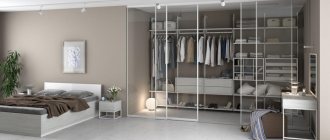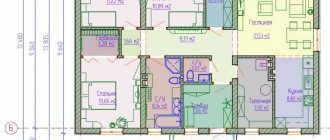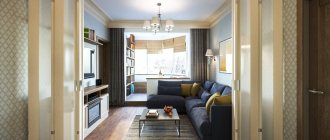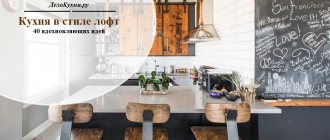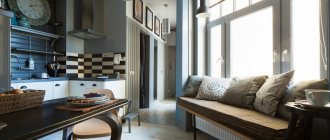Nowadays, a country house is less and less associated with gardening work. Now this is a place for solitude from the bustle of the city. The interior of a country house is different from that of an apartment. Based on whether the building will be used in winter and what tasks it will have to perform, the interior is arranged.
Cottage interior styles
For country interiors, as well as for houses and apartments, the use of styles is relevant. Typically, the following directions are used for landscaping: modern, Scandinavian style, chalet, country, Provence.
Modern style
In a modern style, a country house interior involves the use of wallpaper, paint, stone and brick finishing. The furniture selected is functional and modern without unnecessary frills. When arranging a dacha in this direction, rich and neutral shades, a small table, a fireplace, and minimalist decor will be relevant.
Chalet
Exclusively in a country house, decorated with natural wood and stone, as well as with an installed fireplace, you can create a chalet style. There should be animalistic decor - pottery, handmade textiles, wicker furniture, an attic made of timber, protruding canopies. The room should look like a shepherd's dwelling.
The bedrooms are located on the second floor, the kitchen and living room are on the first floor. Plaster of natural shades, wood whitening agent, and protective varnish are used as finishing materials.
Scandinavian style
Urban furniture and an abundance of decorative elements are things that the Scandinavian country interior does not accept. This style is characterized by calm tones, wooden furniture and decoration, and restraint in decor.
Country
Because of its specificity, the rustic style, or country as it is also called, is very popular among summer residents. It is distinguished by natural shades, flowers in pots, embroidered or checkered textiles, and wooden finishes. A functional stove is suitable to complete the style.
Provence
Provence style is ideal for a summer version of a country house. Thoughtful decorative elements are used here (porcelain tableware, ruffles, cafe curtains, floral embroidery), a fireplace, and special light furnishings.
Textured plaster
Textured plaster mixture is a heterogeneous mixture with which you can obtain textures with a variety of effects. They are created with fillers from ground bricks, pebbles, mica, wood fibers, cotton, etc. The mixture combines with any surface and masks all facade defects. “Lamb”, “Fur Fur”, and Bark Beetle are variants of textured plaster that decorate the houses of many summer residents. A home with a similar decoration of the facade of a country house always looks decent.
Figure 5. Decorative plaster bark beetle.
Decoration of rooms in the country house
Depending on the purpose of the room, there are certain rules for its design.
Kitchen
This room may be small in a country house. But at the same time, it has a basic set of tables and cabinets, as well as all the communications necessary for this room. It is decorated with painted plates, handmade items, curtains, tablecloths, and fresh flowers. A tabletop appropriate for a country house is made of wood, stone, or tile.
Living room
A fireplace in a rustic living room is the main attribute of the house. The interior may vary depending on the chosen style. You can use a large sofa with a massive table, carpets with antique furniture, large tableware, paintings.
Bedroom
On the second floor of a country house, as a rule, there is a bedroom. It is finished with plaster or wallpaper, and the timber is covered with a protective varnish. There must be a hinged wardrobe and chest of drawers. The wooden or metal bed is complemented by drawers in which it is convenient to store things or bedding.
Facade painting
A traditional and economical type of design for the facade of a country house is painting. High-quality paint not only makes it look elegant, but also protects it from factors that adversely affect its preservation. Facade paint is used to finish walls using various materials, both natural and artificial. Usually a roller, brush or spray gun is used. Using the latter requires experience and skill. They are usually painted in 2 layers. Before painting, it is necessary to prime the facade.
Facade paints are divided into types:
- water-based - they are elastic, allow gases and steam to pass through, and are virtually odorless. Within their group they are divided into:
- acrylic - compatible with most surfaces, except those made of silicate and lime components;
- latex - easy to apply, economical, dry quickly; silicone - highly elastic, able to self-clean, resist external negative factors, and vapor permeable;
- acrylic-silicone - combine the best qualities of silicone and acrylic. Environmentally friendly, protect from natural and man-made influences, waterproof, vapor permeable, prevent the development of mold and fungi;
- silicate - optimally suited for mineral surfaces, do not lose their original color for many years;
- lime - these compounds are used on plastered facades and contain antiseptic substances;
- cement - diluted with water before work, forming beautiful, durable, steam-permeable coatings;
- paints with an organic base are good to use, but flammable and toxic;
- oil-based - produced on the basis of drying oil, modern paints with an oil base have high adhesion and resistance to adverse influences, but they quickly fade in the sun;
- alkyd - these enamels are characterized by durability and resistance to temperature changes, but the paints quickly fade and are defenseless against fire and alkalis.
Figure 6. Latex paint.
Attic design
The attic gives the country house the advantage of additional living space. A bedroom or children's room is set up in this place. Windows of different sizes or shapes and the slope of the roof can give an individual look to the attic. Under the arch, drawers are made that will help effectively save space. There is also a games room with board games, parallel bars, and a hammock.
They can make a very stylish attic:
- good natural lighting, which is complemented by lamps and lamps;
- to ensure sufficient natural light, the window is made as open as possible, and curtains of suitable length are used to highlight it;
- necessary built-in furniture that does not clutter up the space;
- painting of walls is carried out according to the principle of zoning, which also allows you to mask the difference between the walls.
